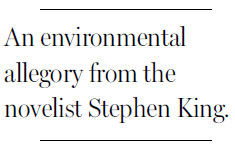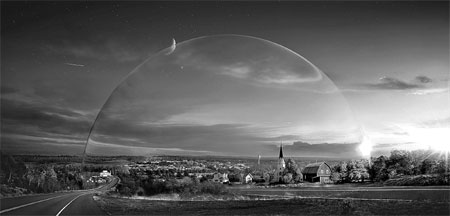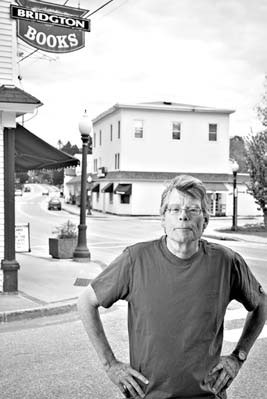Horror, magnified just for television
Updated: 2013-07-07 08:34
By Amy Chozick(The New York Times)
|
|||||||
|
In "Under the Dome," a small town in Maine is suddenly sealed off from the rest of the world. Stephen King began writing the book on which it is based in 1972, and he finished it in 2009. CBS |
|
Stephen King's thriller is inspired by his own environmental worries. Stacey Cramp for The New York Times |

LOVELL, Maine - Rosie's General Store is the type of place where the town's 1,140 residents will stop in to buy lottery tickets, a loaf of bread or the special jumbo lobster roll. It's also the inspiration for the Sweetbriar Rose, a diner in Stephen King's 2009 opus about a small town cut off from the outside world by a mysterious and impenetrable dome.
That novel, "Under the Dome," has been adapted for television, which was why Mr. King found himself talking with the real-life Rose about the TV version of her character, one of nearly 70 in his 1,074-page novel. "I told you I want to be taller and thinner," Rose McKenzie told Mr. King as he ate blueberry pancakes with maple syrup.
"And through the power of narration, you are," he assured her.
After nearly 100 television and film adaptations of his novels and short stories, Mr. King is used to the Hollywood version of his characters ending up younger and more glamorous than their often-haggard literary counterparts. It's one of those things he doesn't try to fight. He has developed a rule about collaborating on adaptations of his work: "Usually my attitude is go all the way in or all the way out," Mr. King said.
Rather than turn the series over to the producers, as he has with other adaptations to varying degrees of success, Mr. King has stayed involved, and it seems fitting. "Under the Dome" encapsulates the arc of his writing career: Started before he became a published novelist, the book was released 37 years later.
Beyond reading the scripts, Mr. King occasionally offers advice. He mostly leaves casting, character arcs, plot development and story lines to the executive producers, who include the comic book writer Brian K. Vaughan and Neal Baer, a longtime writer on the shows "Law & Order: SVU" and "E.R."
The adaptation for the CBS television network, which premiered on June 24, inevitably stresses the visual. In the book, a woodchuck is split in half ("blood squirted and pumped; guts tumbled into the dirt") as the giant dome descends on the fictional town of Chester's Mill, Maine; in the TV version, a cow is severed through computer-generated effects. The Iraq war veteran and cook who assumes the hero's role in the book disposes of a body in the first episode, hinting at a potential murder plot, not found in the novel, that could muddy his image.
After Mr. King downed Ms. McKenzie's pancakes and sausage, he headed to Bridgton, a town that inspired the fictional Chester's Mill. In a gray T-shirt, jeans and black sneakers, he is tall but slight at 65. The weather on this late spring day felt oddly like the sunny fall one he describes as the backdrop of "Dome Day," which is how residents of Chester's Mill refer to the day the dome arrived.
Mr. King started "Under the Dome" in 1972, when he was working as a high school English teacher in Hampden, Maine. He wrote the first chapter about the woodchuck then shelved the idea for more than three decades until he finally felt confident he could tackle the logistics of an entire town trapped, as if in a snow globe. He wrote the original draft, more than 1,500 pages, in 15 months, completing it in March 2009.
"I was on fire," he said of the writing process. "It was great. I loved it."
He said he had always envisioned the dome as an allegory for an environmentally threatened earth and had therefore emphasized to the creators of the TV series that no matter how many departures they take from the novel - and fans of the book will notice many of them - the writers had to retain the important themes.
"I sat down with Brian and Neal and said, 'Don't ever lose sight of the major idea behind 'Under the Dome,' which is we all live under a dome," Mr. King said. "That's it: earth and resources are finite."
Part of what makes "Under the Dome" terrifying, Stephen King-style, is that the reader feels as trapped as the two Dorphans (short for dome orphans) who were cut off from their parents when the structure touched down. And then there are the assorted characters who morph from small-town normalcy to all-out lunacy after Dome Day.
Mr. King does not devote much of his novel to explaining the supernatural origins of the bullet- and missile-proof dome, but the overarching mystery is eventually solved. He wants the television series to do the same, even if it is canceled prematurely.
But if "Under the Dome" is a hit, it could run for multiple seasons, giving Mr. King and the writers tantalizing opportunities to explore dark story lines that didn't make it into the book.
For example, Mr. King left a separate attempt at a story about a community isolated from the outside world unfinished in 1982, when he was living in a depressing apartment complex in suburban Pittsburgh, Pennsylvania. In that telling, it is an apartment building that is cut off; residents grow desperate, and cannibalism ensues.
"I never did get to cannibalism in 'Dome,'" Mr. King said with a grin. "But maybe after three or four seasons ..."
The New York Times
(China Daily 07/07/2013 page12)

